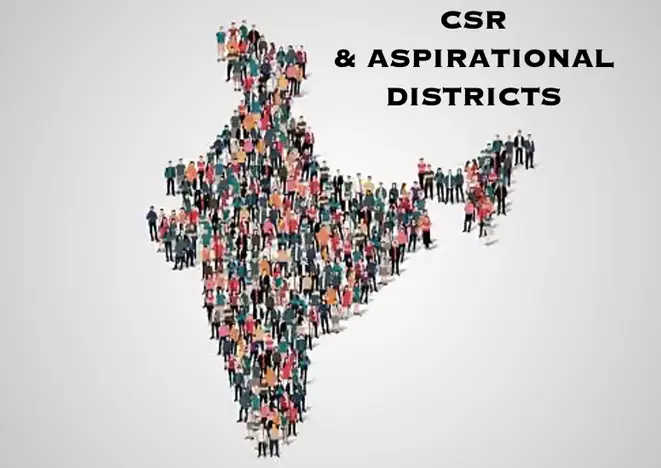Strategic CSR in Aspirational Districts: From Compliance to Competitive Advantage

A Story of Change
As India’s growth narrative unfolds, business leaders have found an unexpected competitive edge: focused investments in the country’s aspirational districts (ADs).
In 2023, Tata Power completely revolutionised its CSR approach – developing a strategy that would simultaneously strengthen its brand value, stakeholder engagement and deliver measurable social impact aligned with national development goals. Moving beyond the traditional trust model of increased donations, the energy giant forged deep partnerships with grassroots NGOs who knew these communities intimately.
This shift transcended regulatory CSR compliance, emerging as a precision-driven campaign that addressed India’s critical development gaps and cemented Tata Power’s leadership position in driving India’s next wave of growth. Although, Tata Power’s transformation exemplifies the potential, understanding the broader context of Aspirational Districts is crucial for appreciating this strategic opportunity.
Understanding the opportunity: Aspirational Districts
Aspirational Districts are 112 regions across 28 states identified by NITI Aayog as India’s most developmentally challenged areas. These districts, home to 15% of India’s population, are tackling layered issues with severe infrastructure gaps in healthcare and education and basic amenities –
- Limited access to quality education and skill development prospects
- High poverty rates and unemployment
- Weak market linkages and economic opportunities
- Environmental vulnerabilities
Since becoming the first nation to mandate corporate social spending in 2014, more than 30,000 companies have invested over ₹1.84 lakh crore into social development programmes, with two-thirds of this amount deployed in just the last five years.
Yet, there is another statistic to consider. 2.15%.
That’s all the CSR funding that reached India’s aspirational districts between 2014-2022, creating a significant resource gap in areas that need it most.
But, where traditional approaches saw obstacles, early-adopters are discovering that opportunities for focused interventions in such untapped markets deliver outsized returns, both in social and business value creation, strongly resonating with investors and regulators alike. Such regions present what investment strategist Nassim Nicholas Taleb calls ‘antifragility’ – the ability to transform volatility into growth.
NITI Aayog’s focus on these regions has created a unique proposition: the chance to demonstrate measurable impact with purposeful foresight and build strong market presence. With the landscape and opportunities clear, examining the measurable impact of interventions in these districts reveals the tangible value of strategic CSR investment.
Measuring What Matters
The public policy think tank’s Aspirational Districts Programme (ADP), launched in 2018, offers a comprehensive framework for measuring development impact. At its inception, the 112 districts averaged a mere 49% on key development indicators. Five years later, through coordinated government activities and deliberate CSR efforts, this figure has surged to 68%.
Here is the granular impact of ADP’s policies –
1. Healthcare Innovation: Infant mortality decreased by 25%, marking a significant advancement in early childhood survival (Institute for Competitiveness, 2024).
Source: Assessment of Aspirational District Program 2.0 – https://www.competitiveness.in/wp-content/uploads/2024/04/Report_Assessment_of_Aspirational_District_Program_2.0.pdf
2. Educational Excellence: Student retention surged, with primary-to-upper primary transition rates climbing from 88% to 95% within two years (NITI Aayog, 2023).
Source: Stories of Change 2022 – https://www.niti.gov.in/sites/default/files/2023-02/Stories_of_Change_2022_1.pdf
3. Infrastructure Impact: School sanitation facilities jumping from 87.6% to 98% illustrate how basic infrastructure investments yield immediate social returns (Harvard Advanced Leadership Initiative, n.d.).
Source: India’s Aspirational Districts Programme Focuses Governance Efforts on Development – https://www.sir.advancedleadership.harvard.edu/articles/indias-aspirational-districts-programme-focuses-governance-efforts-development
4. Future-Ready Workforce: A 63% surge in skill development validates corporate investment in human capital (Institute for Competitiveness, 2024).
Source: Assessment of Aspirational District Program 2.0 – https://www.competitiveness.in/wp-content/uploads/2024/04/Report_Assessment_of_Aspirational_District_Program_2.0.pdf
5. Digital Inclusion: Education (82.73) and Infrastructure (82.34) scores reflect comprehensive progress (NITI Aayog, 2023).
Source: Stories of Change 2022 – https://www.niti.gov.in/sites/default/files/2023-02/Stories_of_Change_2022_1.pdf
6. Poverty Alleviation: Multidimensional poverty fell sharply from 24.85% to 14.96% between 2015-2021, lifting 135 million Indians out of poverty (Institute for Competitiveness, 2024).
Source: Assessment of Aspirational District Program 2.0 – https://www.competitiveness.in/wp-content/uploads/2024/04/Report_Assessment_of_Aspirational_District_Program_2.0.pdf
These impressive outcomes aren’t merely social achievements—they translate into distinct competitive advantages for early movers.
Competitive Edge for Early Movers
Companies investing CSR in Aspirational Districts gain distinct advantages across four key areas that extend beyond compliance:
1. First-Mover Benefits: Early adopters are building deep community relationships and setting industry benchmarks. This first-mover advantage unlocks:
• Market leadership opportunities with uncontested access to emerging growth markets.
• Ideal testing grounds to trial innovative business models and refine them before scaling to similar markets.
• Lasting competitive moat by establishing a strong local presence and gaining early understanding of local market dynamics
2. Innovation Potential: The operational benefits of investing in Aspirational Districts are equally compelling:
• Pilot and refine sustainability-focused business practices for wider implementation.
• Gain early-mover benefits, including favourable government collaboration, preferntial access to public resources and streamlined approvals.
• Strengthen infrastructure and supply chains to reduce risks as these aspirational districts grow into major business hubs.
3. Stakeholder Value: Strategic CSR efforts in Aspirational Districts enhance broader stakeholder relationships, delivering value across the board:
• Demonstrated impact attracts investors, supported by robust sustainability reporting.
• Initiatives offer authentic metrics for social impact, meeting stakeholder demands.
• Early investments build goodwill and a social license to operate as districts evolve.
4. Risk Mitigation: Addressing development gaps helps:
• Reduce operational risks through local stability and community development.
• Enhanced trust via sustainable partnerships and visible regional commitment.
• Better brand value through authentic community engagement
Perhaps the most valuable outcome is the foundation of community trust built through visible commitment to regional development that cements their long-term success as India’s Aspirational Districts transform into tomorrow’s growth markets. Moving from theory to practice, leading Indian companies are already demonstrating how this strategic approach delivers concrete results.
How big corporates are leading by example
Diffused philanthropy of scattered donations have become a thing of the past. Today’s intentional approach is marked by data-driven interventions and coordinated partnerships that create sustainable impact.
The COVID-19 pandemic, rather than derailing this momentum, catalysed an even more targeted approach. Pharmaceutical companies doubled down on healthcare interventions, while tech giants like India’s IT behemoths redirected their focus from sporadic computer donations to establishing full-fledged digital literacy ecosystems to ease the digital divide’s brutal impact on education.
Reliance Industries' Scale-to-Success Model
In Haryana’s Jhajjar district, the Reliance Foundation Bharat India Jodo initiative is an exemplar of how corporate power can be leveraged for maximum impact:
• Government Partnership: Connected 1,800 families with ₹1.4 crore in benefits
• Infrastructure Innovation: Mobilised 51,000 villagers for water security
• Skill Development: Achieved 90% placement rate, scaling to reach 500,000 youth”
Business Impact:
• Enhanced brand presence in rural markets
• Created skilled workforce pipeline
• Strengthened government relationships
IndianOil's Integrated Development Approach
Through a focused investment of ₹150 crore in Bihar’s Purnia district, IndianOil has established integrated development ecosystems that demonstrate how strategic CSR can address multiple development barriers while building business resilience:
• Healthcare Access: Established 15 primary healthcare centre
• Digital Empowerment: Created 20 digital literacy hubs
• Sustainable Livelihoods: Launched farming programmes benefiting 5,000 families
Key Outcomes:
• Stronger community relationships
• Enhanced local infrastructure
• Improved market access
• Sustainable development model
Leverage CSR for Excellence
SEBI’s Business Responsibility and Sustainability Reporting (BRSR) framework has transformed how India’s top 1000 listed companies approach social impact. For forward-thinking organisations, CSR activities in Aspirational Districts now serve a dual purpose – delivering measurable community impact while strengthening ESG performance.
This deliberate alignment manifests across three key dimensions:
1. Environmental Leadership
Beyond traditional philanthropy, companies are architecting sustainable solutions that yield verifiable metrics for ESG reporting:
• Solar-powered schools transforming education access
• Community water treatment systems improving health outcomes
• Waste management interventions creating circular economies
• Renewable energy projects powering rural development
2. Social Impact Indicators
Strategic CSR in India’s aspirational districts is generating rich data on social transformation through:
• Skill development programmes creating employment pathways
• Healthcare initiatives improving community wellbeing
• Educational interventions enhancing human capital
• Community engagement driving sustainable change
3. Governance Excellence
Structured partnerships in ADs demonstrate robust accountability resulting in long-term value creation:
• Public-private collaboration frameworks
• Impact measurement systems
• Stakeholder engagement models
• Transparent reporting mechanisms
Strategic CSR in aspirational districts provides companies with a powerful market differentiator. By fulfilling BRSR mandates, these efforts not only deliver measurable ESG impact but also indicate your company’s capacity to architect meaningful, scalable transformation that attracts investors and strengthens stakeholder trust.
How focusing on ADs can elevate your ESG performance
1. High Impact, Low-Cost Opportunities: Investing in underdeveloped areas offer unprecedented ROI on social impact initiatives, delivering visible results that enhance the credibility of ESG programmes.
2. Alignment with National Goals: Your CSR efforts in these regions automatically align with both government priorities and UN Sustainable Development Goals
3. Rich Data Narratives: These regions provide the comprehensive, measurable impacts that BRSR requirements demand and investors value, offering rich, authentic data for ESG reporting and attracting more capital and investment.
District-level interventions that create lasting community impact consistently deliver superior ESG ratings. By moving beyond compliance with tangible solutions—from solar-powered classrooms to clean water systems—companies showcase authentic social commitment that today’s investors and stakeholders demand.
Seizing tomorrow advantage
India stands at an inflection point in its development journey, where business excellence and national progress are increasingly intertwined. These 112 districts – once seen merely as development challenges – have now emerged as the new frontier of tactical advantage. These growth engines offer a unique convergence of opportunity – the chance to establish market dominance in future markets while delivering measurable social impact.
It’s an opportunity to create value that transcends quarterly reports and annual compliances, building foundations for sustainable growth that benefit both business and society. For companies seeking sustainable growth, the timing is critical. And the time to act is now.

